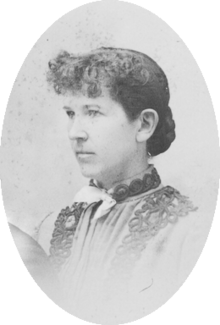Rosa Smith Eigenmann
Rosa Smith Eigenmann (born October 7, 1858 in Monmouth , Illinois , † January 12, 1947 in San Diego , California ) was an American ichthyologist . At first she published alone, later together with her husband Carl H. Eigenmann . As a result of this work, more than 150 species of fish are now credited to Eigenmann & Eigenmann .
Life
Rosa was the youngest of nine siblings. Her parents came to Illinois from California to start a newspaper; but since Rosa was mostly very sickly, the family went back to California and lived in San Diego. Even as a child, Rosa was very interested in nature and joined the San Diego Society of Natural History .
David Starr Jordan visited San Diego in 1879 and met Rosa Smith on the occasion, either at a society meeting or because he was renting a house and horse-drawn carriage from Rosa's father. Around this time, Rosa had discovered that the blind goby Othonops eos (now Typhlogobius californiensis ) lived in caves below Point Loma , a district of San Diego. Jordan was very impressed and encouraged her to study with him at Indiana University . Rosa gladly accepted this offer, went on a research trip to Europe with Jordan in the summer of 1880 and attended the university in Indiana for another two years. However, she then had to return to San Diego because of a family illness. While still at university, she got to know her fellow student Carl Eigenmann better. Both wrote letters to each other when she was back in San Diego. She published regular reports on othonops eos and other species of fish from San Diego . By the time she got married, Rosa had had more than 20 independent publications.
Rosa Smith married Carl Eigenmann on August 20, 1887, after he had obtained his bachelor's degree and moved to California. Then they visited Harvard University together to study the collections there. Rosa was the first woman who was allowed to supervise final semesters. In 1891 Carl became dean of the Indiana graduate school. During this time, Rosa worked with her husband on 15 other research projects, even if the five children she had given birth in the meantime, one of which was disabled, put a lot of strain on her and prevented her from doing research.
When Carl Eigenmann suffered a stroke in 1927, Rosa went back to San Diego with him. She stayed there after his death in April of the same year, but was no longer scientifically active.
Web links
| personal data | |
|---|---|
| SURNAME | Eigenmann, Rosa Smith |
| BRIEF DESCRIPTION | American ichthyologist |
| DATE OF BIRTH | October 7, 1858 |
| PLACE OF BIRTH | Monmouth , Illinois |
| DATE OF DEATH | January 12, 1947 |
| Place of death | San Diego , California |
